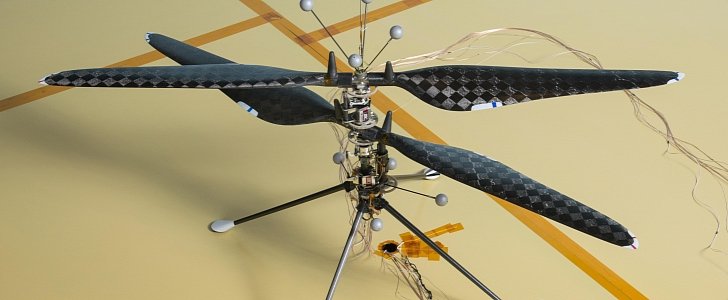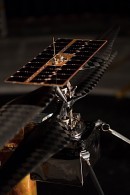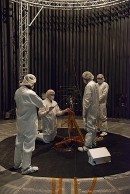When NASA launches its next mission to Mars in 2020, alongside a brand new rover the mission will also call for the deployment of the Mars Helicopter, a small autonomous rotorcraft meant to demonstrate the Martian atmosphere can handle heavier-than-air vehicles flight.
The helicopter is currently undergoing testing at the Space Simulator at the Jet Propulsion Laboratory in Pasadena, California. In January 2019, the Helicopter was put to the test for the first time and flown in controlled conditions.
Inside the Space Simulator, NASA engineers created a medium devoid of nitrogen, oxygen and other gases and filled it with carbon dioxide to mimic the conditions on Mars. Then the Helicopter was fitted with a motorized lanyard to act as a gravity offload system and make the craft believe it is operating in two-thirds of Earth's gravity.
The first flight went without a hitch, and it was soon followed by a second. In all, the helicopter was airborne for one minute at an altitude of 2 inches (5 centimeters) and proved that it can fly in a Mars-like atmosphere.
"Gearing up for that first flight on Mars, we have logged over 75 minutes of flying time with an engineering model, which was a close approximation of our helicopter," said in a statement MiMi Aung, project manager for the Mars Helicopter.
"But this recent test of the flight model was the real deal. This is our helicopter bound for Mars. We needed to see that it worked as advertised."
The Helicopter weighs four pounds (1.8 kg) and has a fuselage about the size of a softball equipped with twin, counter-rotating blades that will spin at 3,000 rpm. In all, 1,500 individual pieces of carbon fiber, flight-grade aluminum, silicon, copper, foil and foam make up the craft.
The Mars 2020 mission, perhaps the most important sent to the Red Planet in history, will take off onboard an Atlas V 541 rocket and is scheduled to land in early 2021.
Inside the Space Simulator, NASA engineers created a medium devoid of nitrogen, oxygen and other gases and filled it with carbon dioxide to mimic the conditions on Mars. Then the Helicopter was fitted with a motorized lanyard to act as a gravity offload system and make the craft believe it is operating in two-thirds of Earth's gravity.
The first flight went without a hitch, and it was soon followed by a second. In all, the helicopter was airborne for one minute at an altitude of 2 inches (5 centimeters) and proved that it can fly in a Mars-like atmosphere.
"Gearing up for that first flight on Mars, we have logged over 75 minutes of flying time with an engineering model, which was a close approximation of our helicopter," said in a statement MiMi Aung, project manager for the Mars Helicopter.
"But this recent test of the flight model was the real deal. This is our helicopter bound for Mars. We needed to see that it worked as advertised."
The Helicopter weighs four pounds (1.8 kg) and has a fuselage about the size of a softball equipped with twin, counter-rotating blades that will spin at 3,000 rpm. In all, 1,500 individual pieces of carbon fiber, flight-grade aluminum, silicon, copper, foil and foam make up the craft.
The Mars 2020 mission, perhaps the most important sent to the Red Planet in history, will take off onboard an Atlas V 541 rocket and is scheduled to land in early 2021.










